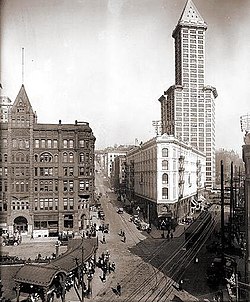This is an old revision of this page, as edited by Cecropia (talk | contribs) at 07:44, 6 January 2005. The present address (URL) is a permanent link to this revision, which may differ significantly from the current revision.
Revision as of 07:44, 6 January 2005 by Cecropia (talk | contribs)(diff) ← Previous revision | Latest revision (diff) | Newer revision → (diff)
Photograph courtesy Seattle Municipal Archives
Pioneer Square is the neighborhood where Seattle, Washington was founded in 1853. It is now a national historic district and a preservation district. It is bound by Alaskan Way S. on the west, beyond which are the docks of Elliott Bay; by S. King Street on the south, beyond which is SoDo; by 4th Avenue S. on the east, beyond which is the International District; and extends between one and two blocks north of Yesler Way, beyond which is the rest of Downtown. (Because of the shift in the street grid north of Yesler, the "border" of the neighborhood zigzags along numerous streets.)
By the end of 1889, Seattle had become the largest city in Washington, with 40,000 residents. That same year, the Great Seattle Fire resulted in the complete destruction of Pioneer Square. Fortunately for the neighborhood, the economy was strong at the time, so Pioneer Square was quickly rebuilt. The new buildings followed a Romanesque Revival architectural style. Because of drainage problems, new development was built at a higher level, literally burying the remains of old Pioneer Square. Visitors can take the Seattle Underground Tour to see what remains of the old storefronts.
Just before the fire, cable car service was instituted from Pioneer Square along Yesler Way to Lake Washington and the Leschi neighborhood. The line was shut down on August 10, 1940. Streetcar service returned to Pioneer Square on May 29, 1982 with the opening of the Waterfront Streetcar.
During the Klondike Gold Rush in 1897 and 1898, Seattle was a center for travel to Alaska. Thousands of so-called "sourdoughs" passed through Seattle, making the city's merchants prosperous. A year later, in 1899, a group of businessmen stole a Tlingit totem pole and placed it in Pioneer Place Park. When an arsonist destroyed the pole in 1938, the city sent the pieces back to the Tlingit tribe, who carved a new one and gave it to Seattle. In addition to the totem pole, a wrought-iron Victorian pergola and a bust of Chief Seattle were added to the park in 1909. The year 1914 saw the completion of the Smith Tower.

In the 1960's, Pioneer Square became a target of urban renewal. One proposal was to replace the buildings with parking garages to serve Downtown Seattle. In 1962, the historic Hotel Seattle was replaced with one such parking garage, which stands to this day. Another proposal was to build a ring road, which would have required destroying many of Pioneer Square's buildings. In 1970, preservationists succeeded in making the neighborhood a national historic district. Later that year, Pioneer Square became a city preservation district.
In early 2001, Pioneer Square suffered three crises. First, in January 15, an 18-wheeler crashed into the pergola, shattering it into thousands of pieces. (It has since been restored.) Next, violence erupted in the neighborhood's Fat Tuesday festivities, during which a young man, Christopher Kime, was fatally beaten. Finally, on February 28, a major earthquake damaged some of the buildings. Had most of them not undergone seismic retrofitting, the damage would have been much worse.
Nowadays, Pioneer Square is home to art galleries, Internet companies, cafés, sports bars, nightclubs, bookstores, and Klondike Gold Rush National Historic Park. It is often described as the center of Seattle's nightlife.
External links
- Pioneer Square Preservation District
- Seattle Post-Intelligencer: Pioneer Square
- Seattle/King Co. HistoryLink.org: Pioneer Square — Thumbnail History